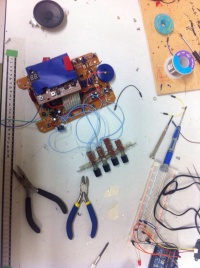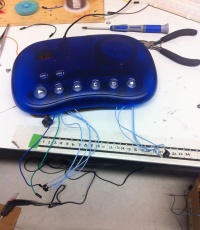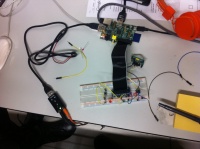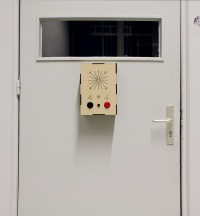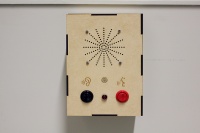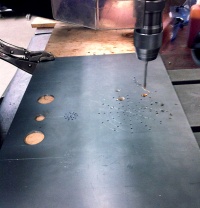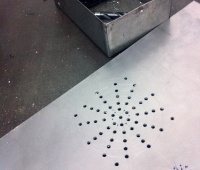User:Yoana Buzova/ latest: Difference between revisions
Yoana Buzova (talk | contribs) |
Yoana Buzova (talk | contribs) |
||
| (79 intermediate revisions by the same user not shown) | |||
| Line 1: | Line 1: | ||
== Tentative Title == | == Tentative Title == | ||
== Introduction == | == Introduction == | ||
During the past nine months I have been experimenting in different fields, using different approaches and tools. | During the past nine months I have been experimenting in different fields, using different approaches and tools. My way of work is observing, collecting and reusing the collected material trough a personal way of encoding it and then decoding it again (an example would be the Street Compositions project). | ||
In the same framework, during the following months I would like to work on a project that deals with collecting sound. I want to investigate the possibility of collecting voices in a fragmented way, and then experiment with analyzing and reusing it. My interest in such a research arises from the idea of initiating a chain of audio messages, left by people in public space. In other words, look at content created within an alternative communication infrastructure. That relates to the chain-like structure of my previous work. | |||
'''Research trajectory''' <br> | |||
I am | We message and communicate all the time, but this more often happens via text and images and usually among a circle of people we are somehow connected to. We usually talk about the same things, comment the same images and share them again and again. Where is sound and voice in our way of communicating? Our mediated communication tools are usually silent. Once we talked over the phone, now we tend to write emails. I think the voice has become somehow recently neglected. I am tempted by neglected moments, objects, mechanisms, so that arises my interest toward it. | ||
Can the poetics and anonymity of the voice be rediscovered to trigger a shift away from the usual mundane communication, provoke different content? Can a self-organised narrative emerge trough a simple, binary message system? A chain that anonymously connects strangers, only trough their voice and lets them react to the last message and thus create a story together. The chain structure suggests unpredictability but connection. Will the voice surprise, provoke? Is our voice something we consider transient? What happens when the messages are recorded and stored and a database available so that anyone, including the passer-by could reveal the whole chain? | |||
I think of the voice chain in public space like throwing a message in a bottle, not an ocean but in a river. The message goes along the flow and reaches a next person that opens it up out of curiosity and has the chance to put his own instead and let the bottle continue the journey. | |||
'''Methodology'''<br> | |||
------ | |||
I will conduct my research by initiating different situations that provide a DIY platform for audio recordings by a public. Those experiments will try to touch on the questions I want to investigate during the following months. | |||
<< [[User:Yoana Buzova/RW3/text1| Here - - > essay on methodology from the third trimester]] >> | |||
*Step one: | |||
part of series of experiments that express and feed my observations : | |||
In public spaces, a sound capturing and playing back device will invite people passing by to record their voice. The last recorded message will be played back aloud every time someone approaches the object. This gives the voice the power to remain and be public, without the subject being present ( just like text). The last recording both serves as a way to attract attention (invite the passer to record his own message) and also a way to construct a loose narrative, as it will be the trigger, context and starting point for the next message. The newly recorded sound becomes the one played aloud. The sounds will be stored in the order they were recorded and the whole 'story' will be accessible to listen online. My experiments will also be researching the idea of taking randomness, but giving it structure, relying on the fact that people will leave a message related to the one before. I will look at that link that goes trough the collected database. | |||
*Step Two: | |||
Me and Max will participate in the Radio Calling event in Tent from 13 to 15 December, where we will create a radioshow based on the recordings made my members of the public via their interaction with the box during the radio calling weekend. | |||
This will be the starting point of actual collection of data, since I was busy with building the diy device. | |||
== Possible outcome == | |||
In the present moment I cannot decide a final outcome but I want to investigate if this chain structure be reused, rearranged or processed algorithmically to create new stories? Some possibilities are: another object that (unlike the one that collects the data) interprets the collection, a radio broadcast, a map that deals with content and location. | |||
== Relation to previous practice == | |||
the previous months I have mainly been working in the model of practice-based research. In the second trimester I started my self-direction project, provoked by the subject of signals and code. My approach was towards encoding and decoding simple urban patterns I collected. I photographed streets at night and then taking them as input, I created a visual code from the lit house windows. The code I played on a music box i built myself. The result are minimal, generative compositions of urban activity. I took information of a large scale ( whole streets and their buildings) to reinterpret it and notably descale it into a gentle sound, coming from a small mechanical object. | |||
As a continuation of the project and aiming to close the loop I started, I built a discrete but resistant urban installation, aiming to bring the data I processed back to its place of origin – the streets. The melodies are looped in speakers, made of concrete, placed in the city. The speakers, in contrast to the music box are resistant, heavy and keep repeating the otherwise transient moments. This iteration where the translated gentle, almost fragile information (composition) is distributed and preserved was the endpoint of the project and made it a complete piece. | |||
Relation of my interest to my previous work described above - ----> This work deals with processes of encoding and decoding and translation of data. It encloses information into tangible objects. Maybe as an unconscious result of my BA studies in photography, I take the position of a viewer, I collect data and use it examine and explore later so it can be the starting point of my work. Work is created during exploring diy strategies, conceptually and physically contrast/different materials and techniques. | |||
I think the same approach can be found in my project proposal. An invitation to an alternative of the fast, always real-time, ephemeral nature of the data we construct together. | |||
== Practical steps == | |||
The steps I will take in the process of developing my work are focused around practice-based research. Similarly I worked throughout my self-directed research during the second and third trimester. | |||
I start by building prototypes of different projects related to the questions I wish to explore. At the same time I will support my research with related readings. | |||
some images of the different prototypes and experiments I have been working on so far: | |||
* In my first experiments I started with playing with obsolete media. I made a presence responsive answering machine, that invites the passer-by to leave a message. | |||
[[File:Vt01.jpg|200 px]] [[File:Vt03.jpg|200 px]] [[File:Vt04.jpg|200 px]] {{vimeo|78054839}} | |||
I also made an online iteration - a website where visitors are asked to leave a recording. ------> [http://message-here.tumblr.com/ prototype] | |||
* My next steps are building a more stable device that is also able to store more recordings and upload them to e remote database. So far I have a working prototype, that still needs some hardware fixes and refinements. I have also made a prototype case. The object works with a raspberry pi, with a mic and a speaker. If the device is connected to the internet, the recordings are instantly uploaded onto a webpage. For this first version a button is used to play the last recording, instead of a sensor. | |||
[[File:Raspi prototype.JPG|200px]] [[File:Broadcast02.jpg|200px]] [[File:Box02.jpg|200px]] {{vimeo|80763217}} | |||
* I also started to work on a steel version of the device. But it is still in process. | |||
[ | [[File:Photo 1.JPG|200px]] [[File:Steel1.jpg|200px]] [[File:Photo 2.JPG|200px]] | ||
My ongoing experiments will be documented in my prototyping page aka [[User:Yoana Buzova/secondyear | WORKLOG ---> click here]]. | |||
My | |||
The steps, discoveries and results of the works will influence and shape my research. | The steps, discoveries and results of the works will influence and shape my research. | ||
== References == | == References == | ||
'Resonant bodies, voices, memories' edited by Anke Bangma, Deirdre M. Donoghue, Lina Issa and Katarina Zdjelar | |||
'Playing with words. The spoken word in artistic practice' Edited by Cathy Lane (2008) | 'Playing with words. The spoken word in artistic practice' Edited by Cathy Lane (2008) | ||
| Line 101: | Line 81: | ||
Dr Hartmut Obendorf, In Search of “Minimalism”— Roving in Art, Music and Elsewhere | Dr Hartmut Obendorf, In Search of “Minimalism”— Roving in Art, Music and Elsewhere | ||
The Voice of New Music by Tom Johnson New York City 1972-1982 A collection of articles originally published in the Village Voice MUSIC | |||
++ tech literature | ++ tech literature | ||
two books by Nicolas Collins Handmade electronic music and Hardware Hacking | two books by Nicolas Collins Handmade electronic music and Hardware Hacking | ||
Latest revision as of 17:21, 2 December 2013
Tentative Title
Introduction
During the past nine months I have been experimenting in different fields, using different approaches and tools. My way of work is observing, collecting and reusing the collected material trough a personal way of encoding it and then decoding it again (an example would be the Street Compositions project).
In the same framework, during the following months I would like to work on a project that deals with collecting sound. I want to investigate the possibility of collecting voices in a fragmented way, and then experiment with analyzing and reusing it. My interest in such a research arises from the idea of initiating a chain of audio messages, left by people in public space. In other words, look at content created within an alternative communication infrastructure. That relates to the chain-like structure of my previous work.
Research trajectory
We message and communicate all the time, but this more often happens via text and images and usually among a circle of people we are somehow connected to. We usually talk about the same things, comment the same images and share them again and again. Where is sound and voice in our way of communicating? Our mediated communication tools are usually silent. Once we talked over the phone, now we tend to write emails. I think the voice has become somehow recently neglected. I am tempted by neglected moments, objects, mechanisms, so that arises my interest toward it. Can the poetics and anonymity of the voice be rediscovered to trigger a shift away from the usual mundane communication, provoke different content? Can a self-organised narrative emerge trough a simple, binary message system? A chain that anonymously connects strangers, only trough their voice and lets them react to the last message and thus create a story together. The chain structure suggests unpredictability but connection. Will the voice surprise, provoke? Is our voice something we consider transient? What happens when the messages are recorded and stored and a database available so that anyone, including the passer-by could reveal the whole chain?
I think of the voice chain in public space like throwing a message in a bottle, not an ocean but in a river. The message goes along the flow and reaches a next person that opens it up out of curiosity and has the chance to put his own instead and let the bottle continue the journey.
Methodology
I will conduct my research by initiating different situations that provide a DIY platform for audio recordings by a public. Those experiments will try to touch on the questions I want to investigate during the following months. << Here - - > essay on methodology from the third trimester >>
- Step one:
part of series of experiments that express and feed my observations :
In public spaces, a sound capturing and playing back device will invite people passing by to record their voice. The last recorded message will be played back aloud every time someone approaches the object. This gives the voice the power to remain and be public, without the subject being present ( just like text). The last recording both serves as a way to attract attention (invite the passer to record his own message) and also a way to construct a loose narrative, as it will be the trigger, context and starting point for the next message. The newly recorded sound becomes the one played aloud. The sounds will be stored in the order they were recorded and the whole 'story' will be accessible to listen online. My experiments will also be researching the idea of taking randomness, but giving it structure, relying on the fact that people will leave a message related to the one before. I will look at that link that goes trough the collected database.
- Step Two:
Me and Max will participate in the Radio Calling event in Tent from 13 to 15 December, where we will create a radioshow based on the recordings made my members of the public via their interaction with the box during the radio calling weekend. This will be the starting point of actual collection of data, since I was busy with building the diy device.
Possible outcome
In the present moment I cannot decide a final outcome but I want to investigate if this chain structure be reused, rearranged or processed algorithmically to create new stories? Some possibilities are: another object that (unlike the one that collects the data) interprets the collection, a radio broadcast, a map that deals with content and location.
Relation to previous practice
the previous months I have mainly been working in the model of practice-based research. In the second trimester I started my self-direction project, provoked by the subject of signals and code. My approach was towards encoding and decoding simple urban patterns I collected. I photographed streets at night and then taking them as input, I created a visual code from the lit house windows. The code I played on a music box i built myself. The result are minimal, generative compositions of urban activity. I took information of a large scale ( whole streets and their buildings) to reinterpret it and notably descale it into a gentle sound, coming from a small mechanical object. As a continuation of the project and aiming to close the loop I started, I built a discrete but resistant urban installation, aiming to bring the data I processed back to its place of origin – the streets. The melodies are looped in speakers, made of concrete, placed in the city. The speakers, in contrast to the music box are resistant, heavy and keep repeating the otherwise transient moments. This iteration where the translated gentle, almost fragile information (composition) is distributed and preserved was the endpoint of the project and made it a complete piece. Relation of my interest to my previous work described above - ----> This work deals with processes of encoding and decoding and translation of data. It encloses information into tangible objects. Maybe as an unconscious result of my BA studies in photography, I take the position of a viewer, I collect data and use it examine and explore later so it can be the starting point of my work. Work is created during exploring diy strategies, conceptually and physically contrast/different materials and techniques.
I think the same approach can be found in my project proposal. An invitation to an alternative of the fast, always real-time, ephemeral nature of the data we construct together.
Practical steps
The steps I will take in the process of developing my work are focused around practice-based research. Similarly I worked throughout my self-directed research during the second and third trimester. I start by building prototypes of different projects related to the questions I wish to explore. At the same time I will support my research with related readings.
some images of the different prototypes and experiments I have been working on so far:
- In my first experiments I started with playing with obsolete media. I made a presence responsive answering machine, that invites the passer-by to leave a message.
I also made an online iteration - a website where visitors are asked to leave a recording. ------> prototype
- My next steps are building a more stable device that is also able to store more recordings and upload them to e remote database. So far I have a working prototype, that still needs some hardware fixes and refinements. I have also made a prototype case. The object works with a raspberry pi, with a mic and a speaker. If the device is connected to the internet, the recordings are instantly uploaded onto a webpage. For this first version a button is used to play the last recording, instead of a sensor.
- I also started to work on a steel version of the device. But it is still in process.
My ongoing experiments will be documented in my prototyping page aka WORKLOG ---> click here. The steps, discoveries and results of the works will influence and shape my research.
References
'Resonant bodies, voices, memories' edited by Anke Bangma, Deirdre M. Donoghue, Lina Issa and Katarina Zdjelar
'Playing with words. The spoken word in artistic practice' Edited by Cathy Lane (2008)
Gregory Bateson 'Steps to an Ecology of Mind' (1972)
Mladen Dolar 'A Voice and Nothing More' (2006)
Yolande Harris, Phd thesis: Scorescapes On Sound Environment and Sonic Consciousness
Dr Hartmut Obendorf, In Search of “Minimalism”— Roving in Art, Music and Elsewhere
The Voice of New Music by Tom Johnson New York City 1972-1982 A collection of articles originally published in the Village Voice MUSIC
++ tech literature
two books by Nicolas Collins Handmade electronic music and Hardware Hacking

